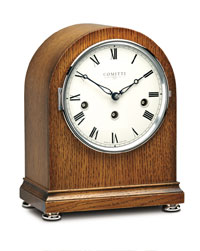
- On unpacking your clock, first check that all packing inside is removed. Then wind up the clock fully
- Check that the surface you are going to put the clock on is level. (It needs to be level or the clock will go out of beat and eventually stop).
- Attach the pendulum to the suspension bar on the back of the movement and then gently hold the pendulum to one side and release. (Alternatively once the pendulum is attached you can gently lift one side of the clock and then lower it to enable it to swing).
- Listen to the clock. It should have an even tick. If this is not the case then the surface you have put the clock on is probably not level.
- To set the clock, move the minute hand gentle round the clock to the correct time. If you have a striking/chiming clock allow the chime to finish before you move the hand on.
- Within a few days you should notice how well the clock is keeping to time. If the clock is going too fast or too slow, you can adjust the timekeeping by screwing the pendulum bob up if the clock is going slow, or down if the clock is going fast. It may take a series of small adjustments over several days to get the clock to keep to the right time. Be patient though, you will eventually get the clock to keep good time.
- Most mantle clocks have an eight day movement, which require winding once a week. Using a smooth action, turn the arbor until the springs are fully wound. (Some people do not like winding the clock fully as the fear they may over wind the spring, but this cannot happen. If the spring has seized, it is because the clock is dirty or worn and therefore needs attention, not because the spring is over wound). If however, you prefer not to wind the clock fully, you can wind the clock throughout the week at a time which is suitable to yourself.
Maintenance
To maintain the clock you should have it checked and serviced every 4-5 years.
- (Please note - Do not attempt to oil the clock yourself. This should be done by a qualified repairer. Over-oiling a clock can affect the running and condition of the clock)
- Check that the surface you are going to put the clock on is level. (It needs to be level or the clock will go out of beat and eventually stop).
- Attach the pendulum to the suspension bar on the back of the movement and then gently hold the pendulum to one side and release. (Alternatively once the pendulum is attached you can gently lift one side of the clock and then lower it to enable it to swing).
- Listen to the clock. It should have an even tick. If this is not the case then the surface you have put the clock on is probably not level.
- To set the clock, move the minute hand gentle round the clock to the correct time. If you have a striking/chiming clock allow the chime to finish before you move the hand on.
- Within a few days you should notice how well the clock is keeping to time. If the clock is going too fast or too slow, you can adjust the timekeeping by screwing the pendulum bob up if the clock is going slow, or down if the clock is going fast. It may take a series of small adjustments over several days to get the clock to keep to the right time. Be patient though, you will eventually get the clock to keep good time.
- Most mantle clocks have an eight day movement, which require winding once a week. Using a smooth action, turn the arbor until the springs are fully wound. (Some people do not like winding the clock fully as the fear they may over wind the spring, but this cannot happen. If the spring has seized, it is because the clock is dirty or worn and therefore needs attention, not because the spring is over wound). If however, you prefer not to wind the clock fully, you can wind the clock throughout the week at a time which is suitable to yourself.

 Default Currency
Default Currency
 US Dollar
US Dollar
